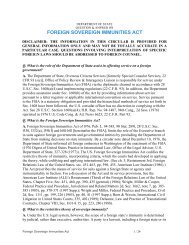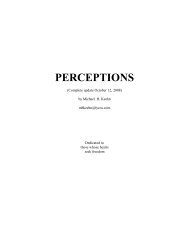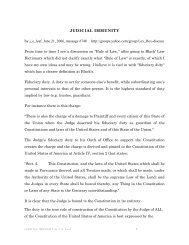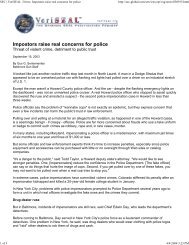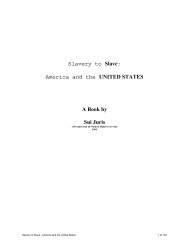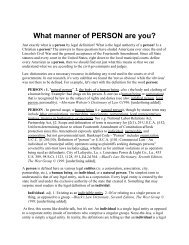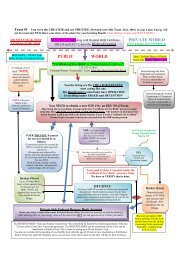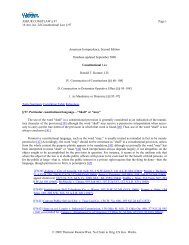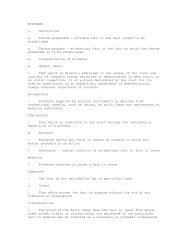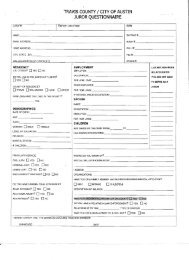Notice Concerning Fiduciary Relationship - Freedom School
Notice Concerning Fiduciary Relationship - Freedom School
Notice Concerning Fiduciary Relationship - Freedom School
Create successful ePaper yourself
Turn your PDF publications into a flip-book with our unique Google optimized e-Paper software.
Form 56 <strong>Notice</strong> <strong>Concerning</strong> <strong>Fiduciary</strong> <strong>Relationship</strong><br />
(Rev. July 2004)<br />
OMB No. 1545-0013<br />
Department of the Treasury<br />
Internal Revenue Service (Internal Revenue Code sections 6036 and 6903)<br />
Part I<br />
Identification<br />
Name of person for whom you are acting (as shown on the tax return) Identifying number<br />
Address of person for whom you are acting (number, street, and room or suite no.)<br />
City or town, state, and ZIP code (If a foreign address, see instructions.)<br />
<strong>Fiduciary</strong>’s name<br />
Address of fiduciary (number, street, and room or suite no.)<br />
City or town, state, and ZIP code<br />
Part II<br />
Authority<br />
1 Authority for fiduciary relationship. Check applicable box:<br />
a(1) Will and codicils or court order appointing fiduciary<br />
b(1) Court order appointing fiduciary<br />
c Valid trust instrument and amendments<br />
d Other. Describe <br />
Part III<br />
Nature of Liability and Tax <strong>Notice</strong>s<br />
Telephone number (optional)<br />
( )<br />
(2) Date of death<br />
(2) Date (see instructions)<br />
2 Type of tax (estate, gift, generation-skipping transfer, income, excise, etc.) <br />
3 Federal tax form number (706, 1040, 1041, 1120, etc.) <br />
4 Year(s) or period(s) (if estate tax, date of death) <br />
5 If the fiduciary listed in Part I is the person to whom notices and other written communications should be sent for all items<br />
described on lines 2, 3, and 4, check here<br />
<br />
6 If the fiduciary listed in Part I is the person to whom notices and other written communications should be sent for some (but not all)<br />
of the items described on lines 2, 3, and 4, check here and list the applicable Federal tax form number and the year(s) or<br />
period(s) applicable<br />
Part IV<br />
Revocation or Termination of <strong>Notice</strong><br />
Section A—Total Revocation or Termination<br />
7 Check this box if you are revoking or terminating all prior notices concerning fiduciary relationships on file with the Internal<br />
Revenue Service for the same tax matters and years or periods covered by this notice concerning fiduciary relationship <br />
Reason for termination of fiduciary relationship. Check applicable box:<br />
a Court order revoking fiduciary authority<br />
b Certificate of dissolution or termination of a business entity<br />
c Other. Describe <br />
Section B—Partial Revocation<br />
8a<br />
b<br />
9<br />
Decedent’s social security no.<br />
Check this box if you are revoking earlier notices concerning fiduciary relationships on file with the Internal Revenue Service for<br />
the same tax matters and years or periods covered by this notice concerning fiduciary relationship<br />
<br />
Specify to whom granted, date, and address, including ZIP code.<br />
<br />
Section C—Substitute <strong>Fiduciary</strong><br />
Check this box if a new fiduciary or fiduciaries have been or will be substituted for the revoking or terminating fiduciary and<br />
specify the name(s) and address(es), including ZIP code(s), of the new fiduciary(ies)<br />
<br />
<br />
For Paperwork Reduction Act and Privacy Act <strong>Notice</strong>, see back page. Cat. No. 16375I<br />
Form 56 (Rev. 7-2004)
Form 56 (Rev. 7-2004)<br />
Part V<br />
Court and Administrative Proceedings<br />
Name of court (if other than a court proceeding, identify the type of proceeding and name of agency) Date proceeding initiated<br />
Address of court<br />
Docket number of proceeding<br />
City or town, state, and ZIP code Date Time a.m. Place of other proceedings<br />
Part VI<br />
Signature<br />
I certify that I have the authority to execute this notice concerning fiduciary relationship on behalf of the taxpayer.<br />
Please<br />
Sign<br />
Here <strong>Fiduciary</strong>’s signature Title, if applicable Date<br />
p.m.<br />
Page 2<br />
Form 56 (Rev. 7-2004)
Form 56 (Rev. 7-2004)<br />
General Instructions<br />
Section references are to the Internal<br />
Revenue Code unless otherwise noted.<br />
Form 56 cannot be used to<br />
update the last known address<br />
of the person for whom you<br />
CAUTION are acting. Use Form 8822,<br />
Change of Address, to make this<br />
change.<br />
Purpose of Form<br />
You must notify the IRS of the creation<br />
or termination of a fiduciary relationship<br />
under section 6903 and give notice of<br />
qualification under section 6036. You<br />
may use Form 56 to provide this notice<br />
to the IRS.<br />
Who Should File<br />
The fiduciary (see Definitions below)<br />
uses Form 56 to notify the IRS of the<br />
creation or termination of a fiduciary<br />
relationship under section 6903. For<br />
example, if you are acting as fiduciary<br />
for an individual, a decedent’s estate, or<br />
a trust, you may file Form 56.<br />
Receivers and assignees for the<br />
benefit of creditors also file Form 56 to<br />
give notice of qualification under section<br />
6036. However, a bankruptcy trustee,<br />
debtor-in-possession, or other like<br />
fiduciary in a bankruptcy proceeding is<br />
not required to give notice of<br />
qualification under section 6036.<br />
Trustees, etc., in bankruptcy<br />
proceedings are subject to the notice<br />
requirements under title 11 of the United<br />
States Code (Bankruptcy Rules).<br />
Definitions<br />
<strong>Fiduciary</strong>. A fiduciary is any person<br />
acting in a fiduciary capacity for any<br />
other person (or terminating entity), such<br />
as an administrator, conservator,<br />
designee, executor, guardian, receiver,<br />
trustee of a trust, trustee in bankruptcy,<br />
personal representative, person in<br />
possession of property of a decedent’s<br />
estate, or debtor-in-possession of assets<br />
in any bankruptcy proceeding by order<br />
of the court.<br />
Person. A person is any individual, trust,<br />
estate, partnership, association,<br />
company or corporation.<br />
Decedent’s estate. A decedent’s estate<br />
is a taxable entity separate from the<br />
decedent that comes into existence at<br />
the time of the decedent’s death. It<br />
generally continues to exist until the final<br />
distribution of the estate’s assets is<br />
made to the heirs and other<br />
beneficiaries.<br />
Terminating entities. A terminating<br />
entity, such as a corporation,<br />
partnership, trust, etc., only has the legal<br />
capacity to establish a fiduciary<br />
relationship while it is in existence.<br />
Establishing a fiduciary relationship prior<br />
to termination of the entity allows the<br />
fiduciary to represent the entity on all tax<br />
matters after it is terminated.<br />
When and Where To File<br />
<strong>Notice</strong> of fiduciary relationship.<br />
Generally, you should file Form 56 when<br />
you create (or terminate) a fiduciary<br />
relationship. File Form 56 with the<br />
Internal Revenue Service Center where<br />
the person for whom you are acting is<br />
required to file tax returns.<br />
Proceedings (other than bankruptcy)<br />
and assignments for the benefit of<br />
creditors. A fiduciary who is appointed<br />
or authorized to act as:<br />
● A receiver in a receivership proceeding<br />
or similar fiduciary (including a fiduciary<br />
in aid of foreclosure), or<br />
● An assignee for the benefit of<br />
creditors, must file Form 56 on, or within<br />
10 days of, the date of appointment with<br />
the Chief, Special Procedures Staff, of<br />
the area office of the IRS having<br />
jurisdiction over the person for whom<br />
you are acting.<br />
The receiver or assignee may also file<br />
a separate Form 56 with the service<br />
center where the person for whom the<br />
fiduciary is acting is required to file tax<br />
returns to provide the notice required by<br />
section 6903.<br />
Specific Instructions<br />
Part I—Identification<br />
Provide all the information called for in<br />
this part. If there is more than one<br />
fiduciary, each fiduciary must file (or<br />
otherwise give notice) a separate<br />
Form 56.<br />
Name. File a separate Form 56 for each<br />
person for whom you are acting in a<br />
fiduciary capacity. For example, if you<br />
will be filing the decedent’s final Form<br />
1040 and are the executor/administrator<br />
of the decedent’s estate, file one Form<br />
56 entering the name of the decedent as<br />
the person for whom you are acting and<br />
file one Form 56 entering the name of<br />
the estate as the name of the person for<br />
whom you are acting.<br />
Identifying number. If you are acting for<br />
an individual, an individual debtor, or<br />
other person whose assets are<br />
controlled, the identifying number is the<br />
social security number (SSN). If you are<br />
acting for a person other than an<br />
individual, including an estate or trust,<br />
the identifying number is the employer<br />
identification number (EIN).<br />
Decedent’s SSN. If you are acting on<br />
behalf of a decedent, enter the<br />
decedent’s SSN shown on his or her<br />
Part II—Authority<br />
Page 3<br />
final Form 1040 in the space provided. If<br />
you are acting on behalf of a decedent’s<br />
estate that must file a Form 706, United<br />
States Estate (and Generation-Skipping<br />
Transfer) Tax Return, enter the<br />
decedent’s SSN in addition to entering<br />
the EIN (if applicable) as discussed<br />
above under Identifying number.<br />
Address. Include the suite, room, or<br />
other unit number after the street<br />
address.<br />
If the postal service does not deliver<br />
mail to the street address and the<br />
fiduciary (or person) has a P.O. box,<br />
show the box number instead of the<br />
street address.<br />
For a foreign address, enter the<br />
information in the following order: city,<br />
province or state, and country. Follow<br />
the country’s practice for entering the<br />
postal code. Please do not abbreviate<br />
the country name.<br />
Line 1a. Check the box on line 1a if the<br />
decedent died testate (i.e., having left a<br />
valid will) and enter the decedent’s date<br />
of death.<br />
Line 1b. Check the box on line 1b if the<br />
decedent died intestate (i.e., without<br />
leaving a valid will). Also, enter the<br />
decedent’s date of death and write<br />
“Date of Death” next to the date.<br />
Assignment for the benefit of<br />
creditors. Enter the date the assets<br />
were assigned to you and write<br />
“Assignment Date” after the date.<br />
Proceedings other than bankruptcy.<br />
Enter the date you were appointed or<br />
took possession of the assets of the<br />
debtor or other person whose assets are<br />
controlled.<br />
You must be prepared to<br />
furnish evidence that<br />
substantiates your authority to<br />
CAUTION act as a fiduciary for the<br />
person for whom you are acting.<br />
Part III—Nature of Liability<br />
and Tax <strong>Notice</strong>s<br />
Line 2. Specify the type of tax involved.<br />
This line should also identify a transferee<br />
tax liability under section 6901 or<br />
fiduciary tax liability under 31 U.S.C.<br />
3713(b) when either exists.<br />
Line 5. If you check the box on line 5,<br />
we will treat your address as the<br />
address for IRS notices and<br />
correspondence for the form(s) and<br />
period(s) listed on lines 3 and 4.<br />
Line 6. If you check the box on line 6,<br />
we will treat your address as the<br />
address for IRS notices and<br />
correspondence for the form(s) and<br />
period(s) that you list on line 6.
Form 56 (Rev. 7-2004)<br />
Part IV—Revocation or<br />
Termination of <strong>Notice</strong><br />
Complete this part only if you are<br />
revoking or terminating a prior notice<br />
concerning a fiduciary relationship.<br />
Completing this part will relieve you of<br />
any further duty or liability as a fiduciary<br />
if used as a notice of termination.<br />
However, completing Section B or C<br />
does not relieve any new or substitute<br />
fiduciary of the requirement to file a<br />
Form 56 or to otherwise give notice.<br />
Part V—Court and<br />
Administrative Proceedings<br />
Complete this part only if you have been<br />
appointed a receiver, trustee, or fiduciary<br />
by a court or other governmental unit in<br />
a proceeding other than a bankruptcy<br />
proceeding.<br />
If proceedings are scheduled for more<br />
than one date, time, or place, attach a<br />
separate schedule of the proceedings.<br />
Assignment for the benefit of<br />
creditors. You must attach the following<br />
information:<br />
1. A brief description of the assets<br />
that were assigned, and<br />
2. An explanation of the action to be<br />
taken regarding such assets, including<br />
any hearings, meetings of creditors, sale,<br />
or other scheduled action.<br />
Part VI—Signature<br />
Sign Form 56 and enter a title describing<br />
your role as a fiduciary (e.g., assignee,<br />
executor, guardian, trustee, personal<br />
representative, receiver, or conservator).<br />
Paperwork Reduction Act and Privacy<br />
Act <strong>Notice</strong>. We ask for the information<br />
on this form to carry out the Internal<br />
Revenue laws of the United States. Form<br />
56 is provided for your convenience and<br />
its use is voluntary. Under section 6109<br />
you must disclose the social security<br />
number or employer identification<br />
number of the individual or entity for<br />
which you are acting. The principal<br />
purpose of this disclosure is to secure<br />
proper identification of the taxpayer. We<br />
also need this information to gain access<br />
to the tax information in our files and<br />
properly respond to your request. If you<br />
do not disclose this information, we may<br />
suspend processing the notice of<br />
fiduciary relationship and not consider<br />
this as proper notification until you<br />
provide the information.<br />
You are not required to provide the<br />
information requested on a form that is<br />
subject to the Paperwork Reduction Act<br />
unless the form displays a valid OMB<br />
control number. Books or records<br />
relating to a form or its instructions must<br />
Page 4<br />
be retained as long as their contents<br />
may become material in the<br />
administration of any Internal Revenue<br />
law. Generally, tax returns and return<br />
information are confidential as required<br />
by section 6103.<br />
The time needed to complete and file<br />
this form will vary depending on<br />
individual circumstances. The estimated<br />
average time is:<br />
Recordkeeping 8 min.<br />
Learning about the<br />
law or the form 32 min.<br />
Preparing the form 46 min.<br />
Copying, assembling, and<br />
sending the form to the IRS 15 min.<br />
If you have comments concerning the<br />
accuracy of these time estimates or<br />
suggestions for making this form<br />
simpler, we would be happy to hear<br />
from you. You can write to the Tax<br />
Products Coordinating Committee,<br />
Western Area Distribution Center,<br />
Rancho Cordova, CA 95743-0001. Do<br />
not send Form 56 to this address.<br />
Instead, see When and Where To File on<br />
the prior page.



